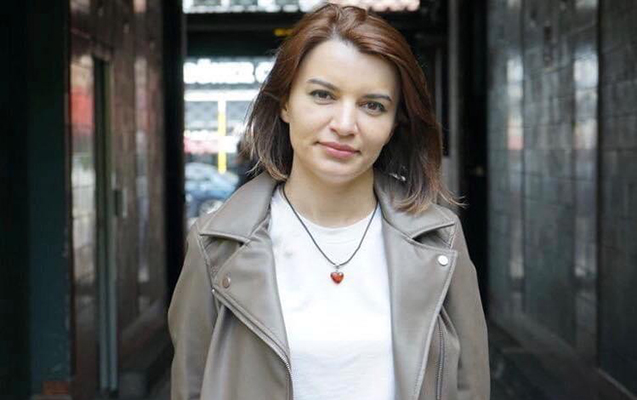A prison worker, who is herself an inmate, forcefully wedges the meat taken from the cells into the decaying, worn-out “Chinar” refrigerator, pushing it into the ice-blocked corner, then grabs the detached door standing aside and somehow manages to close it. The female worker steps back and watches for a while, just in case the fridge’s rotted door falls off again, so she can lift it and put it back.
This is how summer looks in Baku Pretrial Detention Centre, from its 196-million-manat share. Why 196 million? Because that’s how much has been allocated to the Penitentiary Service from this year’s state budget - 196 million 864 thousand 793 manats.
We set out to trace the presence of that money inside the detention center.
“I’m begging you, find a way”
Let’s start with the refrigerator room designated for storing food for the 153 women held in the women’s ward.
Since the prison doesn’t provide quality food, inmates have to ask for it from their families. Inmates are allowed one visit per week, and they send the food their families bring to the refrigerators for weekly storage. There are only 9 refrigerators for the food and water of 153 people. One of them - the more functional one - was bought by the inmates themselves. One doesn’t work at all. Four of the refrigerators still carry Soviet markings. Small, rotting Soviet-era fridges - food spoils quickly even when they’re refrigerated.
“I’m begging you, find a way” - is the desperate plea of an inmate who wants to place her food in the refrigerator but hears that there’s no space. The fridge doors can barely be closed because of the crushed and piled-up food. The prison worker, unable to ignore the pleas, takes the food and then has to spend a long time figuring out where to place it. She opens every fridge, rummaging through them, and finally sets someone’s food aside for a while so the new one can chill before the other thaws.
Arguments frequently arise between the inmate worker and other detainees. The reason is that the food their families bring with such effort ends up spoiling. The female worker swears it’s not her fault - the refrigerators are too few and mostly broken, so the food goes bad. As the verbal dispute between two inmates grows louder, the prison staff watch as if they’re watching a play. The scapegoat is the inmate worker. She’s the one who clashes with everyone, takes the blame, and tries to calm them down. As if none of this is the responsibility of the prison staff.
The detention center is supposed to be equipped with supplies based on inmates’ needs. That should be covered in the 196 million manat. But no one remembers the last time a new refrigerator was brought to the ward. All anyone ever says is that this problem has always existed.
The deputy warden, Ahad Abdiyev, has “found” a solution to the refrigerator shortage. He’s ordered the fridges to be pumped up with gas, saying they’ll work better after that. But no one can guarantee the doors won’t fall off once that’s done.
When prisoners can’t find cold water in the fridge, they turn to their cells in hopes of finding cool air. But fans aren’t provided based on the number of people. For example, in Cell 41, where 11 people are held, there are only 3 fans - all bought by the prisoners themselves. The detention center hasn’t given them any.
In Cell 46, which also holds 11 people, there are 4 fans: one bought by inmates, three provided by the facility.
In Cell 33, with 10 inmates, there are just two fans - one of which was bought from the prison store for 40 manats. The facility gave just one fan for 10 people. One of the women in this cell is pregnant. In Cell 71, meant for 10 but holding 12, two people sleep on the floor. There are 3 fans and all purchased by the prisoners. The institution hasn’t given anything.
In Cell 53, 11 inmates share 3 fans, which prisoners say were left behind by former detainees.
Cell 48 holds 11 people and has 4 fans. Cell 54 has 10 people and 3 fans. Cell 38 has 8 people and 4 fans. All of these fans were either bought by the inmates or left behind by previous ones. The institution didn’t provide them.
The list could go on, but we’ve shared these few examples to give you a clear picture.
Fan shortages and chlorine-scented water
Recently, a guard went cell to cell with a inmate worker, asking, “How many ventilators (fans) do you have?” The inmates were hopeful - thinking their needs were finally being considered and that new fans would be provided. But later it turned out the purpose was to collect the old, broken fans and repair them, that’s what the list was for. So their hopes of breathing a little easier this summer were dashed. Since there’s no ventilation or cooling system in the prison, fans are the only way to get any relief. The building was built through corrupt practices, which is why no ventilation system was ever installed. And those who later ran the prison haven’t shown any will to fix it.
Prisoners pin their hopes on the little air that might slip in through the narrow vents and the windows opening onto the recreation yards - enclosed on all sides and covered with barbed wire. From 11 a.m. to 5 p.m., the rooms are flooded with sunlight, and it becomes hard to breathe. Those with health conditions suffer the most from the stifling heat and lack of air. Inmates with high blood pressure, diabetes, and heart problems struggle to get through the season. And since there is no qualified doctor in the detention center, they can’t get the treatment they need.
Inmates wanting to cool off by washing up in the summer heat can’t even find water. In winter, cold water is supplied for three hours a day, in summer, it’s been cut to two. When the water comes, that time is spent refilling the containers that were emptied throughout the day. These containers take up nearly half the already cramped cells.
The water isn’t suitable for drinking, it smells of chlorine. No one in the detention center knows when the tanks that supply it were last cleaned.
The women’s wing receives hot water only twice a week, for a total of five hours. In cells holding 10, 11, or 12 women, they’re forced to bathe two at a time just to manage within that window.
The water temperature is never normal during showers. It’s either scalding hot or freezing cold. Inmates’ pleas to adjust the water temperature are only heard - if at all - right before the water gets shut off.
Some cells don’t have a shower system at all. To bathe, you either have to kneel down under a faucet or place a basin and wash yourself with a small container. Basic bathroom equipment is in extreme shortage throughout the detention center.
Most inmates who need hot water daily for washing themselves or their dishes are not given water heaters. They heat water in electric kettles instead. Because of constant use, the kettles often break - and again, it’s the inmates who have to buy replacements.
Another workaround is to place 20-liter water containers in the yard and wait for the sun to heat them. But carrying these containers back and forth from the yard to the cell causes inmates to develop back pain.
In a detention center already suffering from water shortages, cleaning supplies are also not provided. In this matter too, inmates are left to depend entirely on their families.
When the women held in the detention center ask the administration for proper ventilation, a working refrigerator, or more water each day, they receive just one reply: “This is a prison, not a holiday resort.”
And yet, over the past five years, 837 million manats have been allocated from the state budget to the Penitentiary Service - including for feeding prisoners and keeping them in decent conditions. In the women’s wing, we haven’t seen a single trace of that money.
If the State Audit Office were to conduct an audit of the Penitentiary Service’s institutions, it would become clear whose “holiday” was funded by the money that was meant to be spent on inmates.
Authors: Sevinc Vagifqizi, Nargiz Absalamova, Elnara Gasimova







